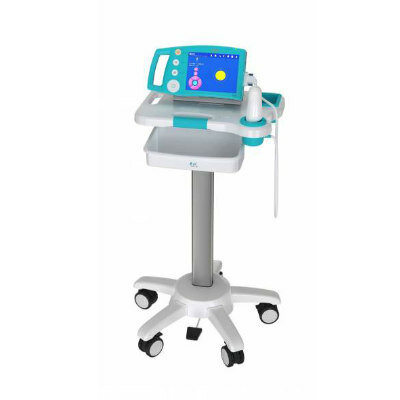Low-Dose Molecular Breast Imaging (MBI) Could Improve Cancer Detection in Dense Breast Tissue
|
By MedImaging International staff writers Posted on 02 Feb 2023 |

Traditional mammography is often less able to clearly image tumors due to the density of the breast tissue. Molecular breast imaging (MBI) technology uses a radioactive tracer that ‘lights up’ areas of cancer in the breast and is effective even in dense breast tissue – which is prevalent in people who are at higher risk of cancer. However, MBI currently involves a much greater exposure to radiation than mammograms. Now, two research programs will aim to further develop low-dose MBI technology based on cadmium zinc telluride CZT-based SPECT (single-photon emission computed tomography) detector technology.
CZT is transforming gamma detectors used in medical imaging, leading to better diagnosis, faster treatment and lower costs for hospitals. The change from conventional scintillator technology to CZT is similar to upgrading from a black-and-white vacuum-tube television to a color digital high-definition flat-screen TV. Kromek (Sedgefield UK), which is at the forefront of CZT detector development, provides a way for medical device manufacturers to be part of this transformation sooner, integrate CZT gamma detectors into their SPECT systems, and bring new products to market cost-effectively. Kromek’s CZT-based SPECT detector technology uses low-dose MBI – to provide effective cancer detection with lower radiation exposure. CZT creates much clearer images and requires far lower radiation doses to do so, than comparable detectors, enabling the solution to deliver eight times less radiation than existing MBI technology. Kromek has now been awarded funding from the UK’s innovation agency, Innovate UK, for two research programs to further develop a low-dose MBI technology based on the company’s CZT-based SPECT detectors.
“Current routine breast screening does not meet everyone’s needs because of its shortcomings in detecting cancers in dense breast tissue, a particular concern for younger women. Low-dose molecular breast imaging, which solves this, has the capacity to save thousands more lives, detecting cancers earlier, before they have time to spread,” said Arnab Basu, CEO of Kromek Group. “This helps not only the patient, but also the public health authorities who can provide the right treatment earlier and, ultimately, more cost effectively. This additional funding from Innovate UK will allow us and our partners to collate the data needed to progress to clinical tests and then deployment. We look forward to working with our partners to complete the program.”
Related Links:
Kromek
Latest General/Advanced Imaging News
- New AI Method Captures Uncertainty in Medical Images
- CT Coronary Angiography Reduces Need for Invasive Tests to Diagnose Coronary Artery Disease
- Novel Blood Test Could Reduce Need for PET Imaging of Patients with Alzheimer’s
- CT-Based Deep Learning Algorithm Accurately Differentiates Benign From Malignant Vertebral Fractures
- Minimally Invasive Procedure Could Help Patients Avoid Thyroid Surgery
- Self-Driving Mobile C-Arm Reduces Imaging Time during Surgery
- AR Application Turns Medical Scans Into Holograms for Assistance in Surgical Planning
- Imaging Technology Provides Ground-Breaking New Approach for Diagnosing and Treating Bowel Cancer
- CT Coronary Calcium Scoring Predicts Heart Attacks and Strokes
- AI Model Detects 90% of Lymphatic Cancer Cases from PET and CT Images
- Breakthrough Technology Revolutionizes Breast Imaging
- State-Of-The-Art System Enhances Accuracy of Image-Guided Diagnostic and Interventional Procedures
- Catheter-Based Device with New Cardiovascular Imaging Approach Offers Unprecedented View of Dangerous Plaques
- AI Model Draws Maps to Accurately Identify Tumors and Diseases in Medical Images
- AI-Enabled CT System Provides More Accurate and Reliable Imaging Results
- Routine Chest CT Exams Can Identify Patients at Risk for Cardiovascular Disease
Channels
Radiography
view channel
Novel Breast Imaging System Proves As Effective As Mammography
Breast cancer remains the most frequently diagnosed cancer among women. It is projected that one in eight women will be diagnosed with breast cancer during her lifetime, and one in 42 women who turn 50... Read more
AI Assistance Improves Breast-Cancer Screening by Reducing False Positives
Radiologists typically detect one case of cancer for every 200 mammograms reviewed. However, these evaluations often result in false positives, leading to unnecessary patient recalls for additional testing,... Read moreMRI
view channel
PET/MRI Improves Diagnostic Accuracy for Prostate Cancer Patients
The Prostate Imaging Reporting and Data System (PI-RADS) is a five-point scale to assess potential prostate cancer in MR images. PI-RADS category 3 which offers an unclear suggestion of clinically significant... Read more
Next Generation MR-Guided Focused Ultrasound Ushers In Future of Incisionless Neurosurgery
Essential tremor, often called familial, idiopathic, or benign tremor, leads to uncontrollable shaking that significantly affects a person’s life. When traditional medications do not alleviate symptoms,... Read more
Two-Part MRI Scan Detects Prostate Cancer More Quickly without Compromising Diagnostic Quality
Prostate cancer ranks as the most prevalent cancer among men. Over the last decade, the introduction of MRI scans has significantly transformed the diagnosis process, marking the most substantial advancement... Read moreUltrasound
view channel
Deep Learning Advances Super-Resolution Ultrasound Imaging
Ultrasound localization microscopy (ULM) is an advanced imaging technique that offers high-resolution visualization of microvascular structures. It employs microbubbles, FDA-approved contrast agents, injected... Read more
Novel Ultrasound-Launched Targeted Nanoparticle Eliminates Biofilm and Bacterial Infection
Biofilms, formed by bacteria aggregating into dense communities for protection against harsh environmental conditions, are a significant contributor to various infectious diseases. Biofilms frequently... Read moreNuclear Medicine
view channel
New SPECT/CT Technique Could Change Imaging Practices and Increase Patient Access
The development of lead-212 (212Pb)-PSMA–based targeted alpha therapy (TAT) is garnering significant interest in treating patients with metastatic castration-resistant prostate cancer. The imaging of 212Pb,... Read moreNew Radiotheranostic System Detects and Treats Ovarian Cancer Noninvasively
Ovarian cancer is the most lethal gynecological cancer, with less than a 30% five-year survival rate for those diagnosed in late stages. Despite surgery and platinum-based chemotherapy being the standard... Read more
AI System Automatically and Reliably Detects Cardiac Amyloidosis Using Scintigraphy Imaging
Cardiac amyloidosis, a condition characterized by the buildup of abnormal protein deposits (amyloids) in the heart muscle, severely affects heart function and can lead to heart failure or death without... Read moreImaging IT
view channel
New Google Cloud Medical Imaging Suite Makes Imaging Healthcare Data More Accessible
Medical imaging is a critical tool used to diagnose patients, and there are billions of medical images scanned globally each year. Imaging data accounts for about 90% of all healthcare data1 and, until... Read more
Global AI in Medical Diagnostics Market to Be Driven by Demand for Image Recognition in Radiology
The global artificial intelligence (AI) in medical diagnostics market is expanding with early disease detection being one of its key applications and image recognition becoming a compelling consumer proposition... Read moreIndustry News
view channel
Bayer and Google Partner on New AI Product for Radiologists
Medical imaging data comprises around 90% of all healthcare data, and it is a highly complex and rich clinical data modality and serves as a vital tool for diagnosing patients. Each year, billions of medical... Read more





















